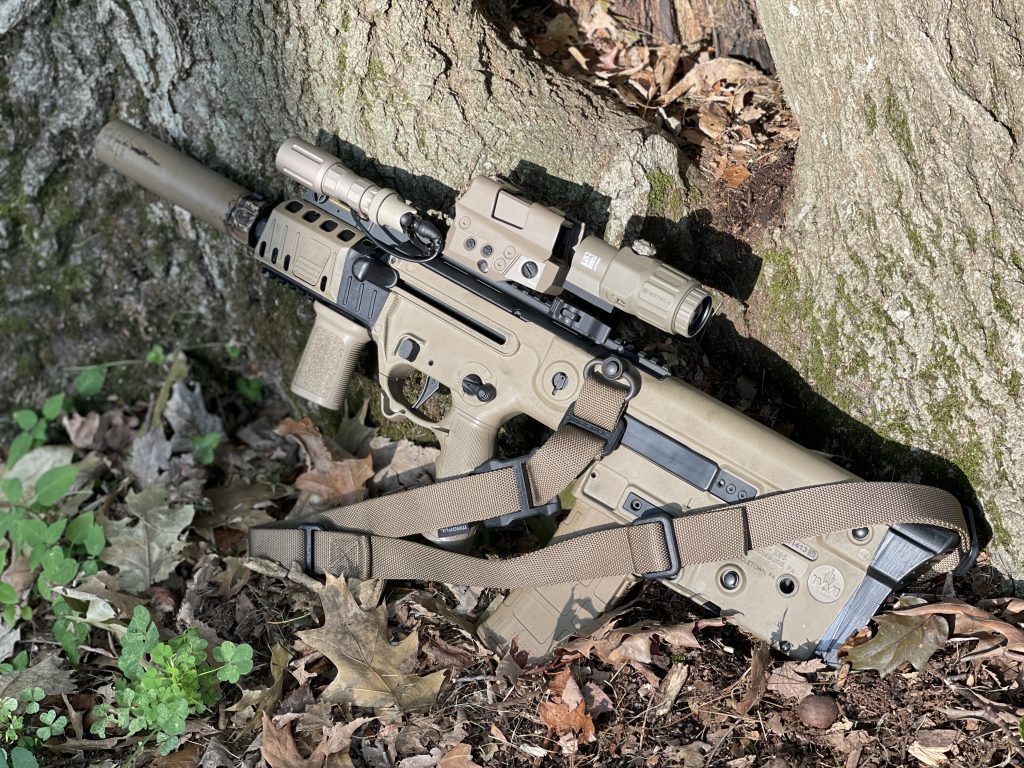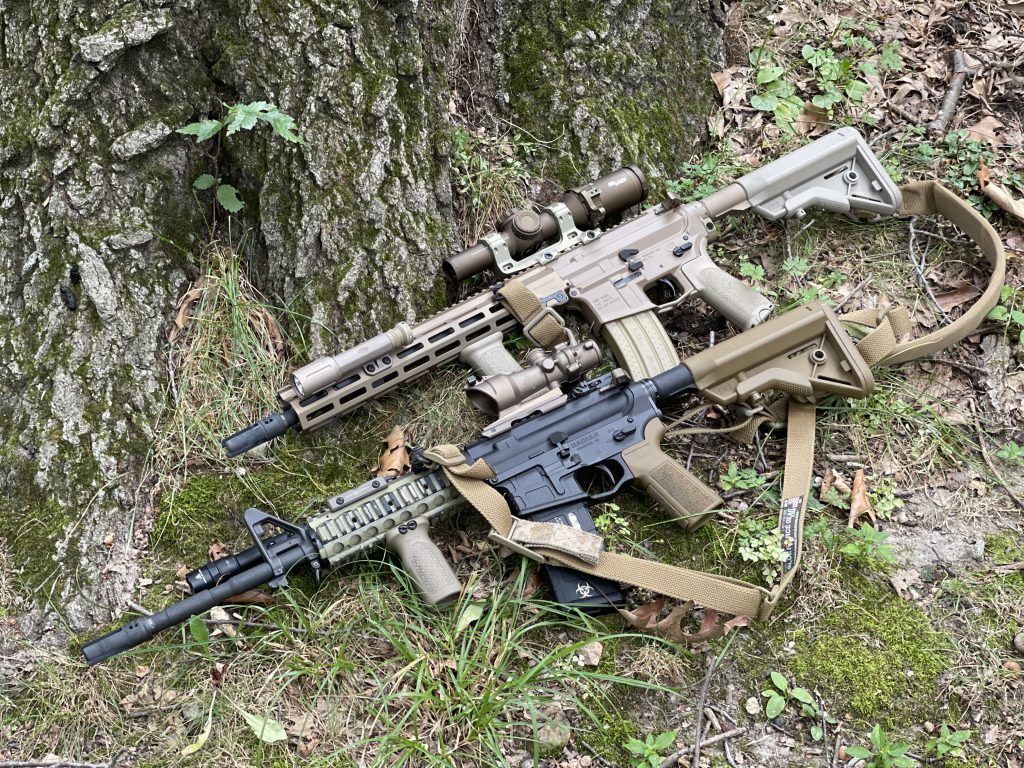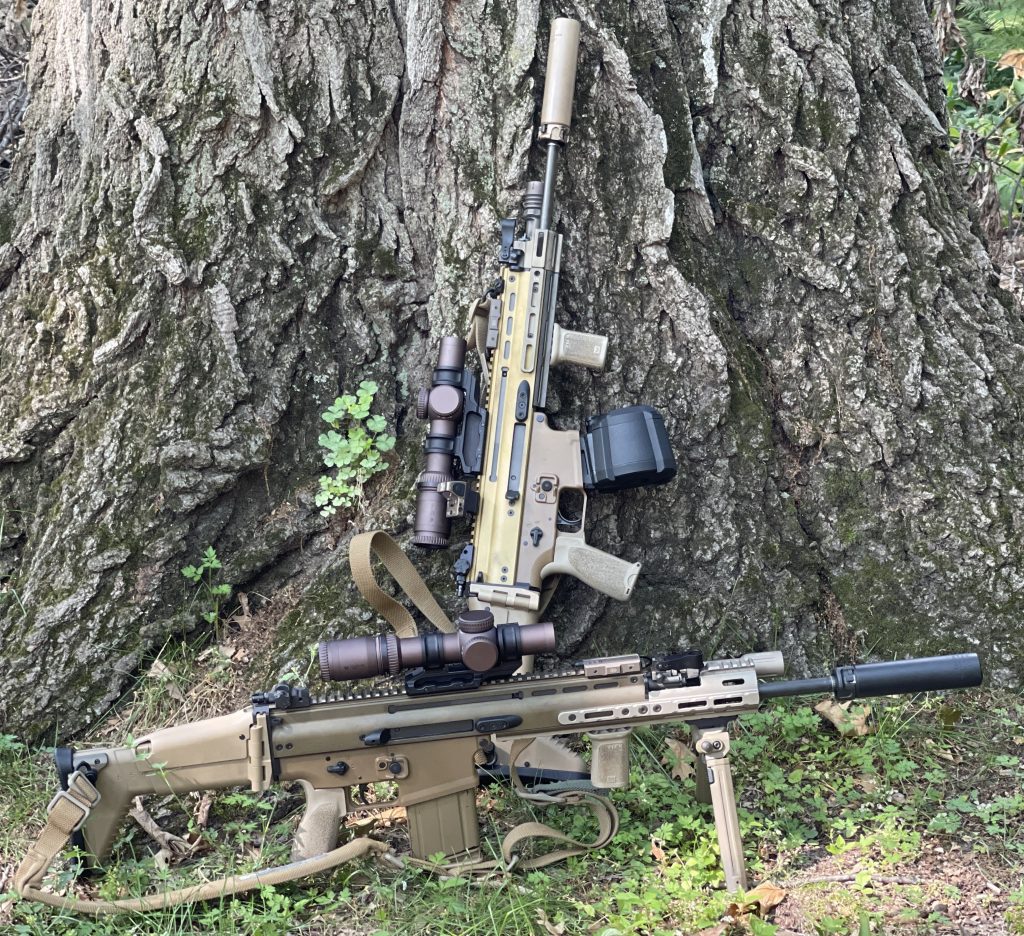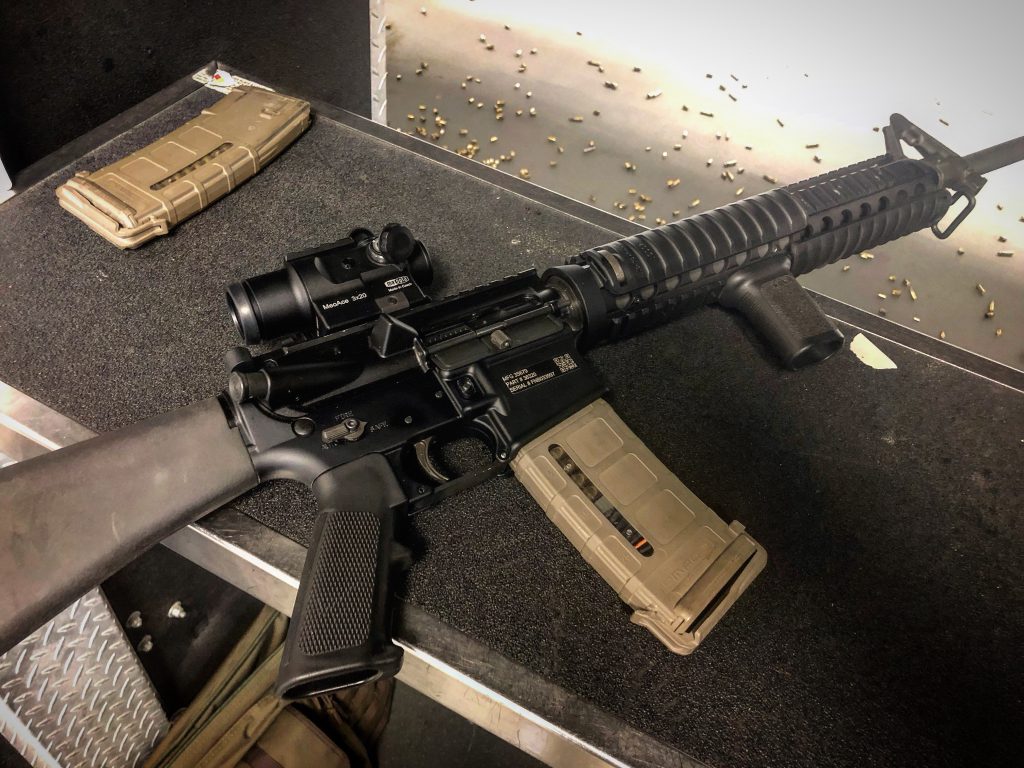
Our rifles have gotten shorter. For a minute there they went a bit too short in certain calibers (7.5″ 5.56 is wild, ladies and gents), but nowadays a 16″ barreled 5.56x45mm NATO rifle is… long.
Sixteen inches of rifled barrel is RECCE, DMR, “Precision” even if the barrel can hold up to the name, and our general use carbines have shortened. We’ve even found ways to keep these shorter and shorter guns Title I under the NFA with creative muzzling for we in the normal purchasing pool.
Why?
Doors.
That is a gross oversimplification, but an accurate one.
Doors, meaning urban, suburban, and rural dwelling spaces, are an unavoidable consideration when it comes to setting up a modern fighting carbine. Even in uniformed conventional conflict, you will go into tight spaces eventually. As much as feasible, your rifle shouldn’t get in your way.
That brings us back to doors. The modern doorway is 36″ wide, give or take. That is the US Standard. That’s pretty close to universal because adult sized people don’t vary too much dimensionally, we have very well defined averages and standards for living and transit spaces.
It is no coincidence that the XM7 is 36″ with it suppressor. The L403A1 is a similar length with its 13.7″ barrel and compact suppressor attached. The MK18 and CQBR line of carbines ran a 6.5″ NT4 suppressor and were, you guessed it, about 36″ long with that on. Most modern infantry carbines across modern militaries are averaging around this length, often either with or without a suppressor being the closest to 36″ based upon whether the rifle is envisioned to run with or without the suppressor for ‘normal’ operation.
See the M4A1, M27, HK417F/A7/A8, C8A3, SCAR-L MK2, XM7, MK17, and so forth.
But my muzzle velocity?
We’ve been tuning our ammo for the shorter barrels too, while doing it no harm in the longer guns (mostly… looking at you M855A1), all-in-all we’re nicely adapting to the reality that size matters. It matters because we humans take up and live within a recognizable space. Just like the width of modern train tracks was determined by cart wheels and a pair of horses long long ago, the width of a door accommodates our convenience because we have an adult size range that is only rarely inappropriate. Sizing our equipment to work within these common narrow points in our environments is logical. There is too big, there is too small, and we’re finding that keeping our carbines 26-36 inches in overall length is just right.
The IDF has been doing this since the TAVOR SAR introduction at the turn of the century and US users have modified our bullpups to accommodate suppressors in many cases without exceeding that 36 mark. European militaries envisioned APC and mechanized heavy combat in urban spaces and bullpups were often adopted (FAMAS, L85, AUG) to accommodate. As AR-15’s and conventional rifle peers have shortened, the need for a bullpup to fit these spaces has been shelved partially or totally by many of these militaries. Not all, the bullpup still has strong characteristics and I doubt we ever see its retirement. There are several strong modern iterations and I would bet the 2020’s will see one or two more.
All things balanced as we learn and grow
You can track the ‘Goldilocks’ barrel length range of the year on modern guns through the real world trial and error of operational forces. Kevin Owens, if I recall correctly, has an anecdote about firing his MK18 in lowlight or dark conditions but missing its suppressor and having a hail of angry bees (bullets) sent his way in return. Muzzle signature lesson of the real world at war.
Short AR’s aren’t new, Colt introduced them very early. But the thinking, implementation, and augmentation of them has modernized with the advances in quality optics and suppressors. That paired with the real world realized advantages has shifted modern though processes when it comes to equipping someone for a modern fight.
We’ve learned things about what we can do with ammunition to balance its performance and still hit certain must have minimums. We’ve found these shorter rifles can still reach out when they have to, especially with optics, and that our modern optical suites allow someone with a general purpose carbine to effectively cover that 300 meter ‘most combat occurs’ envelope more efficiently than ever without having a cumbersomely long weapon. The XM7 is looking to stretch that envelope to 1,000 meters, mechanically at least.
The last decades substantial strides in performance and form on these systems, especially ancillary optics and suppressors, has allowed us to cut some barrel length back and make the rifles run better than ever. Stacking incremental improvements.
While not all that different at a basic level, and even with the reduced muzzle velocity, a modern SBR running an LPVO is much better equipped for a fight that could shift from close spaces to 300 meters plus ranges than the M16A1 ever was.
The Lucky Number: 13
Thirteen inches seems to be the magic number, give or take. The X95 default is 13″, the MK17 usually 13″, the XM7 is 13″, the L403A1 is 13.7″ although I am reliably told they wanted 12.5 (reportedly the rail would be just too short to accommodate a program mandated NV/Thermal optic, highly believable), The HK417A2 is 13″, MARS-H Battle Rifle is 13.5″ and so on. Those last two join the XM7 and MK17 as battle rifles that, while meeting that size envelope, can command some space.
A few more close quarters leaning platforms like 11-11.5″ barrels and others continue the M4A1’s 14.5″ (like the HK416A7/A8 and SCAR-L MK2) but 13″ seems to be the new golden number. We have seen just enough reduction in length to accommodate suppressors into the space requirements we want without performance dropping below requirements at distance. Not all militaries are moving forward with suppressors as aggressively as the US, but everyone has to go through doors.
What should YOU do?
Is it time for you to ditch ye olde sixteen inch?

No.
As JRR Tolkien admonished us through his character of Treebeard, Fangorn of Sindarin, don’t be hasty. You don’t lightly give up a good thing for a slightly better thing wastefully.


The well worn 16″ and 14.5″ pinned guns still hunt just fine. Ditching a rifle you have time and trust in to chase a moderately more optimally sized one so you don’t get stuck in a doorway is silly.
You don’t drop a working a gun for no reason. We go through this in IWI Academy all the time, you don’t ditch a working gun. You don’t ‘transition to pistol’ without a reason and you don’t ditch a working rifle for a likely NFA (although certain 13.7’s are pinned) carbine just because it is the bleeding edge of cool.
Where you look to make the change and optimize is when you were going to make a change and/or an upgrade anyway.
You’re on the market for a new gun? Think your home defense carbine could benefit from being a little shorter? Buy that 12.5″ instead of another 16″ this time. Looking to update your agency’s cruiser rifles and you recall just how much a pain in the ass it is to take a 6920 in and out of the car? Time to go short. Saw that video where the pursuit car with two cops had the partner firing the AR inside the car and it was clearly world shatteringly loud? Short and suppressed.
Upgrade your equipment personally and professionally when the resource bandwidth is available. But there is no need to rush that spend if you have a good resource in hand.
However, new owners can look at these latest and greatest options afresh and benefit most by picking them from the onset. Picking an option with modern optimizations for modern spaces should absolutely be on that considerations list. You aren’t replacing an item you have in hand already, because you don’t have one yet, so there is no overlap ‘waste’ in your resource outlay.

What do I mean?
I mean that someone like myself, and all other firearm owners who have a reasonably modern rifle and optic suite, gain far less by purchasing or building that 12.5″ SBR with LPVO and offset dot than a consumer who doesn’t have a rifle yet.
If I have either of these here below, even the “old” M4 with old profile barrel, ACOG, and a couple generations old Surefire light, and even as my only rifle…

Then going to this with its 1-10x FFP Zoom, offset sealed red dot sight, floated CHF 12.5″ barrel, A5 buffer system, and on, and on, and so forth, doesn’t net me much gain. Arguably the gain is purely theoretical, other than the shorter gun is easier to move around inside with when one of my cans are on it.
That was one of the characteristics I was going for so success. Gun accomplishes goals. But if you’re thinking about it in terms of what I gained from the M4 it is incremental, from the URG-I style one its an even smaller increment.

Those previously invested costs and capabilities of older system stack against the new one. Think of it like spending $2.00 for each dollar the new system costs if the old one has that capability too, if it has most of that capability then most of the cost of the old system gets doubled into the new one, because you are buying most of it again. This doesn’t mean don’t buy if you have a rifle, it is a way of objectively mapping the cost/benefit of the new gun. If you have a threshold you have to justify, looking at you agency buyers, then this is a good way to do so along with paralleling the maintenance and partial upgrade cost options to your current inventory. IE: $X,XXX per new rifle with all these A, B, C functionalities. Then $Y,YYY per rifle to maintain what is current and not have or have reduced A, B, or C functionality over replacement units. Finally $Z,ZZZ per unit to upgrade current items and will gain D, E, and F function, but less A, B, C by this much.
If your rifle is fairly far behind the progress curve you aren’t redundantly spending nearly as much. Going from a largely stock M16A4 with a fixed power optical sight, the USMC standard until the mid 2010’s, to the SBR above changes your capabilities quite substantially. You spent money again that you had spent on the older rifle, but you gained fit and function in most or all categories you needed or preferred the rifle to fit better to.

But if you are starting from no rifle then every dollar you spend cannot be spent again. New owners and users benefit the most from the lessons previous owners and users have learned.
So run some numbers and go get yourself an upgrade if the math is mathin’.



